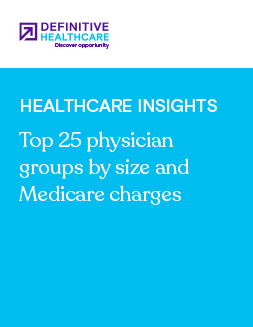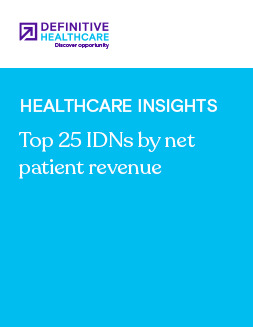Healthcare Insights
A look at hospital operating margins in the United States
Over the past few years, hospitals have experienced increasing costs coupled with decreasing net patient revenue, ultimately impacting their bottom line.
Hospitals use operating margins to measure and track how much they spend on expenses – everything from doctors’ salaries to medical supplies – and then compare it to their revenue – the money that they receive from patients, insurance companies, and the government for delivering patient care. Operating margin can be used to compare provider organizations and provide insight into their financial performance.
In this Healthcare Insight, we review operating margins at U.S. hospitals in relation to their bed quantity and physical location.
How do you calculate operating margin for a hospital?
In the Definitive Healthcare HospitalView product, operating margin is calculated using metrics from the Medicare Cost Report. The difference between net patient revenue and total operating expense is divided by the net patient revenue to create an operating margin percentage.
In this Healthcare Insight, we review hospital profits, or operating margins, at U.S. hospitals in relation to their bed quantity and geographic location. The latest data is based on the January 2024 release of the Medicare Cost Report, and results in this analysis are aggregated from the last five full calendar years of hospital financial data tracked in our database.
What are operating margins for U.S. hospitals?
Based on data from more than 5,600 hospitals in the Definitive Healthcare HospitalView product, the median operating margin for U.S. hospitals in 2022 was actually a loss of 3.8%. Meanwhile, the average operating margin for hospitals was a loss of 13.5%.
Hospital operating margins range from more than -50% to upwards of 28%. Since average hospital margins vary more widely, we compared median values for our following analysis.
Average and median hospital operating margins
Fig. 1 Data is from the Definitive Healthcare HospitalView product and sourced from the Medicare Cost Report. Accessed March 2024.
How do hospital operating margins change each year?
Based on analysis of historical hospital operating margins, many hospitals run on a small loss each year and do not have high profit margins. In 2018, 2019, and 2021, median hospital operating margins were about -1%.
In 2020, the median operating margin dropped to -5.3%, likely due to reduced capacity and delays in care related to the COVID-19 pandemic. This financial strain continued in 2022, with hospital margins hovering around -4%, possibly related to the overall economic climate of inflation and rising costs in the U.S.
Hospital operating margin by bed size
Fig. 2 Data is from the Definitive Healthcare HospitalView product and sourced from the Medicare Cost Report. Accessed March 2024.
Small hospitals with 25 beds or fewer have the lowest operating margins. In 2022, these hospitals reported a median operating margin of more than -6%. Over the last three years, hospitals with 26 to 100 beds had the highest median operating margins — even a positive result of 1.6% in 2021.
Hospital operating margin by region
Fig. 3 Data is from the Definitive Healthcare HospitalView product and sourced from the Medicare Cost Report. Accessed March 2024.
Hospitals in the northeastern U.S. have the lowest median operating margin at -8.7% and historically have the lowest operating margins compared to other regions across the country. The northeast hospitals also had some of the largest drops in average net patient revenue, likely contributing to the hospital profit margin results.
Hospitals across all regions had negative median operating margins in 2022. In 2021, the southeast and southwest were the only regions where hospitals had a positive median operating margin.
Learn more
Healthcare Insights are developed with healthcare commercial intelligence from the Definitive Healthcare platform. Want even more insights? Start a free trial now and get access to the latest healthcare commercial intelligence on hospitals, physicians, and other healthcare providers.


